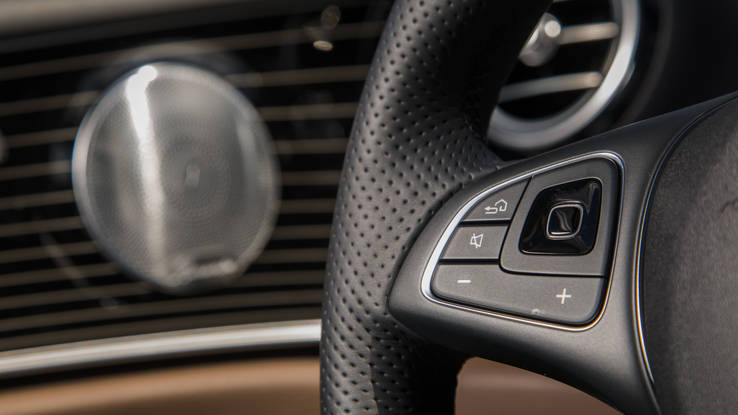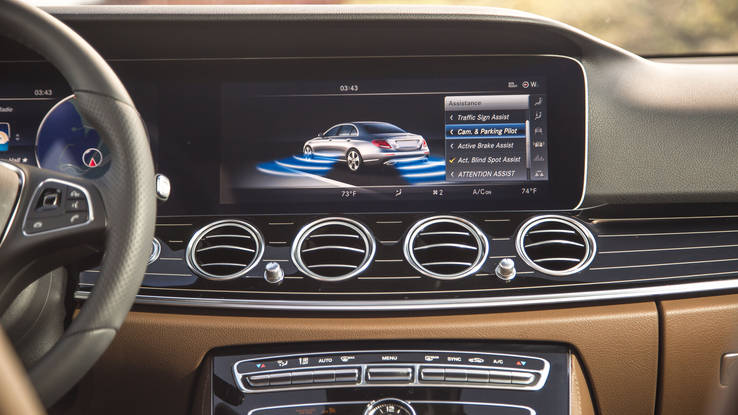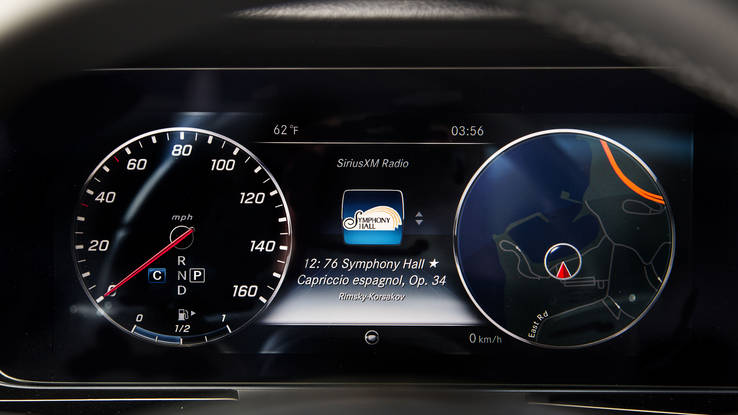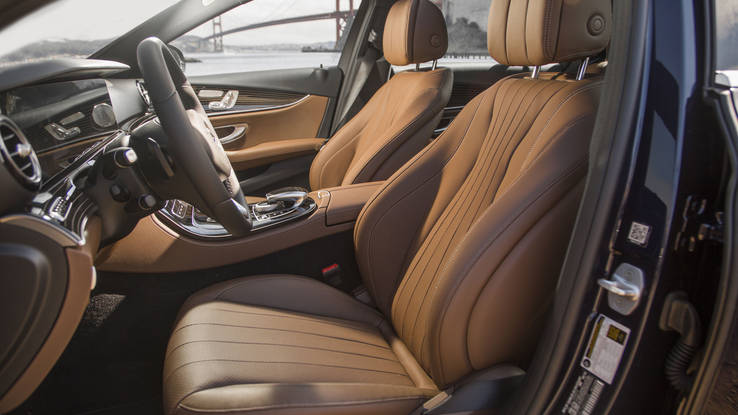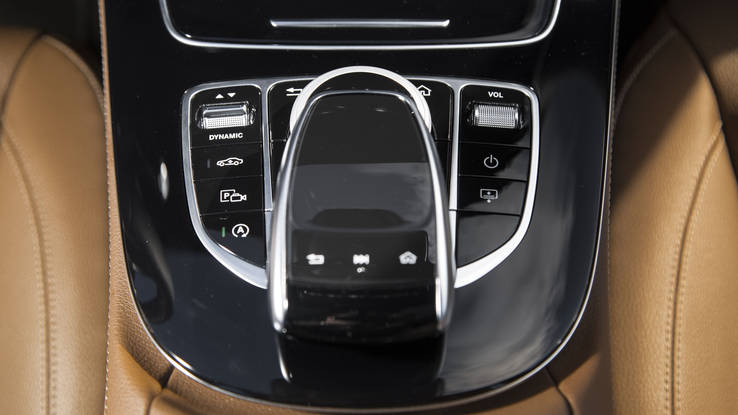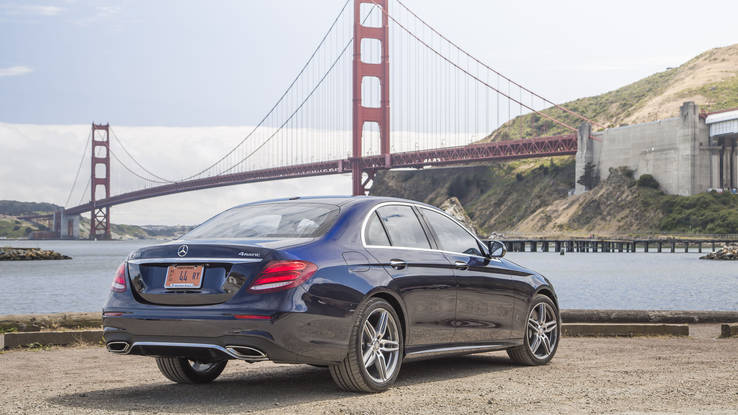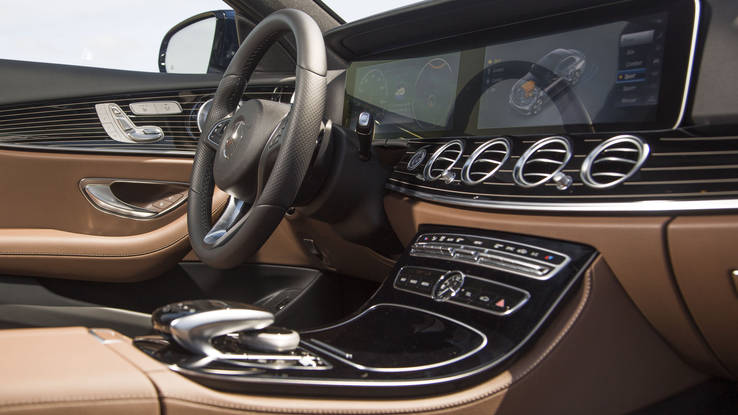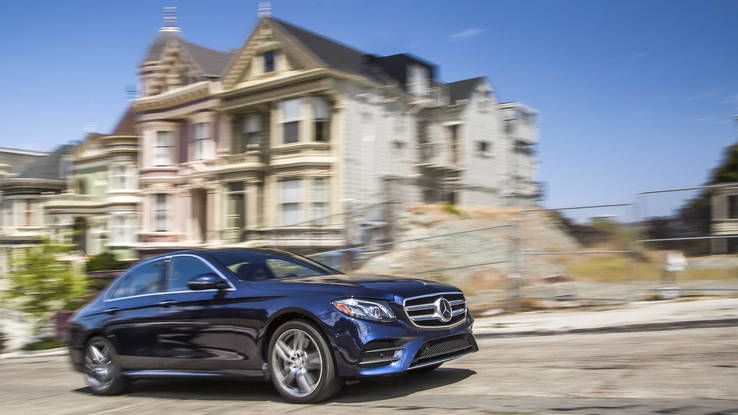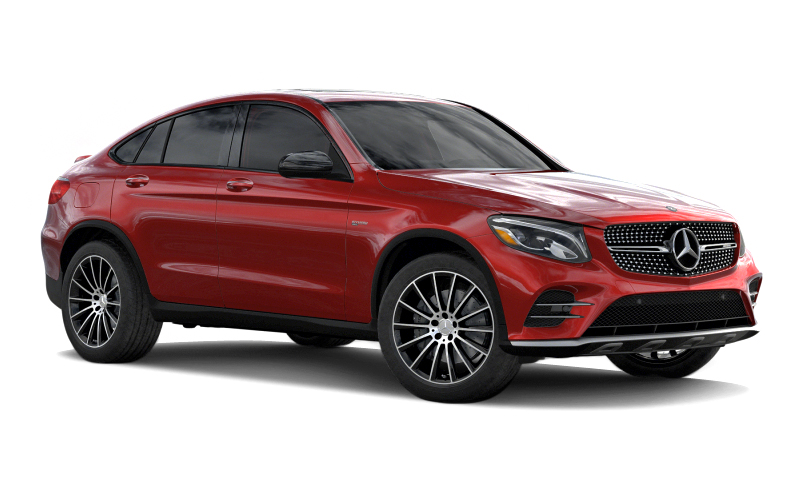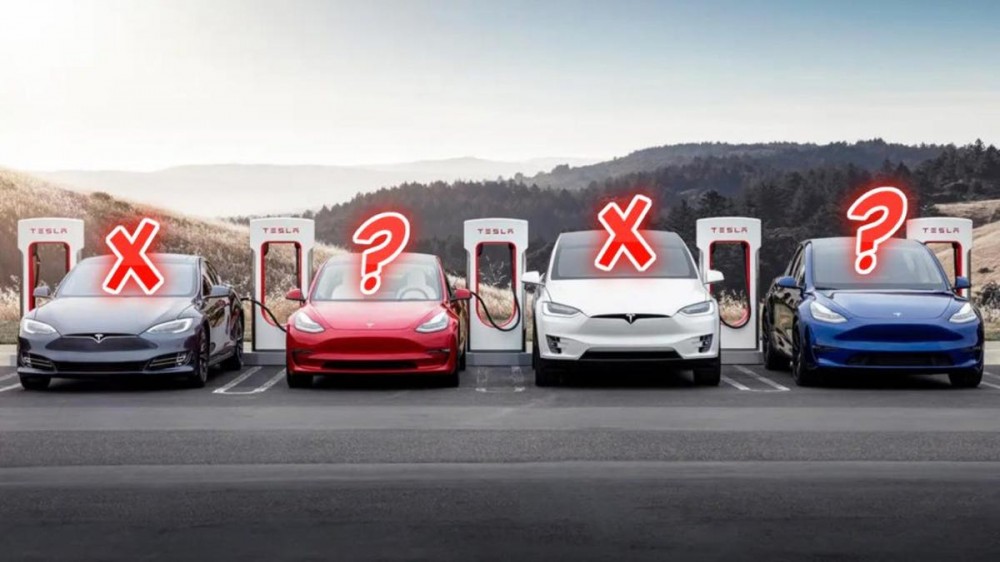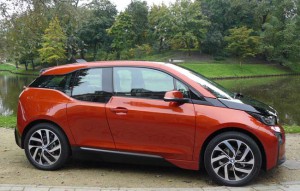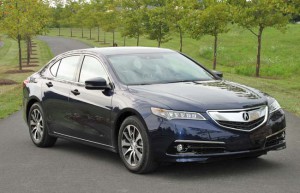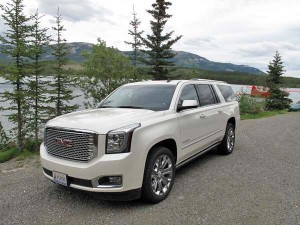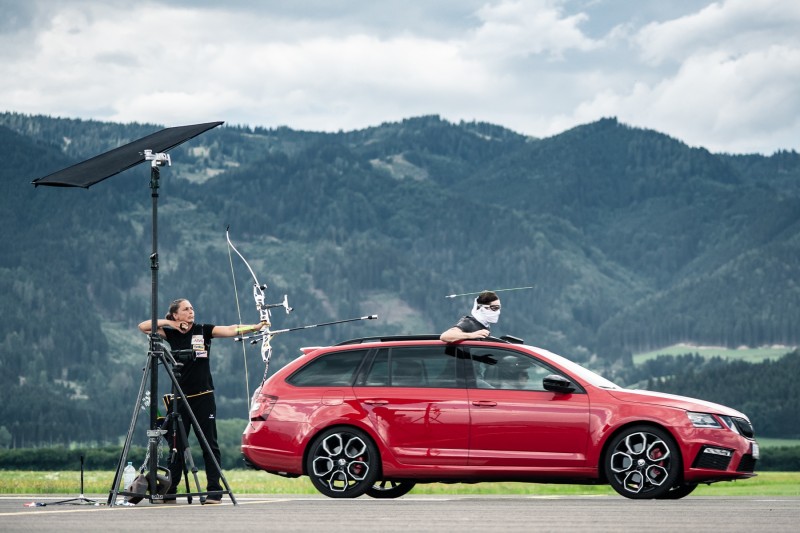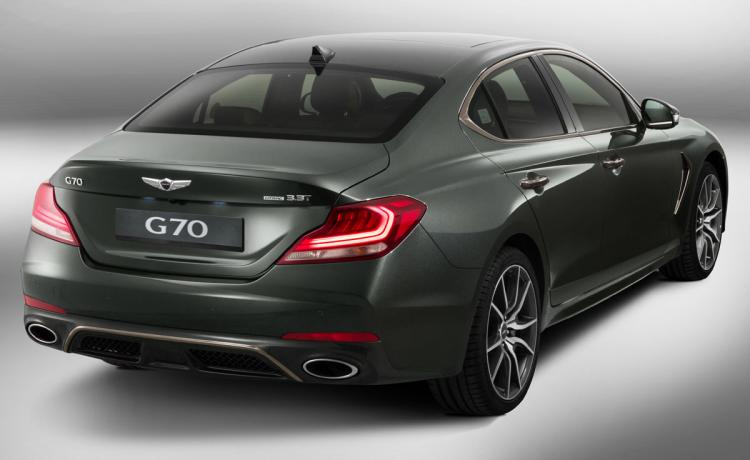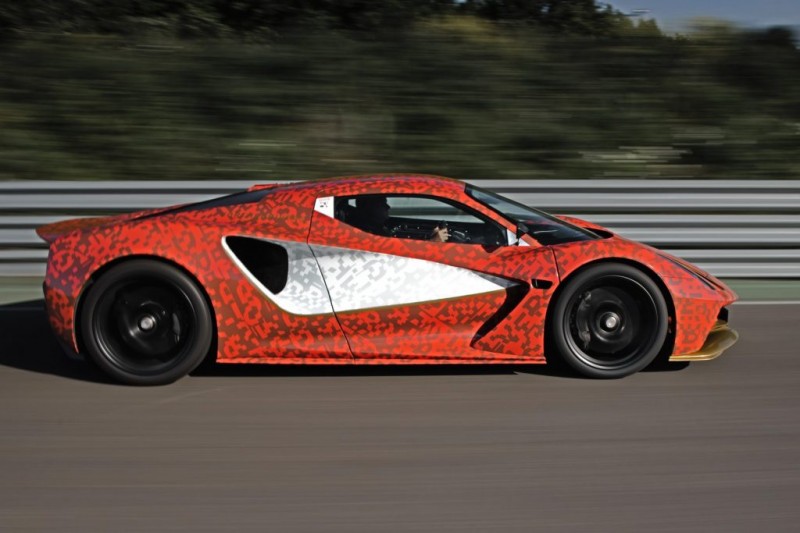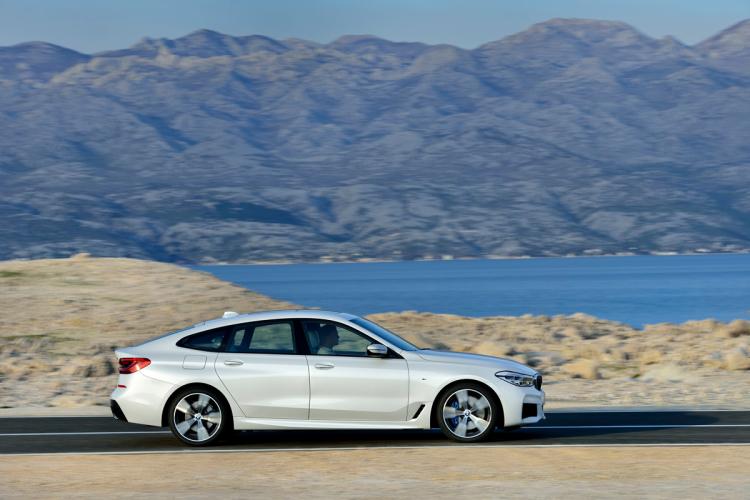Testing the tech on the 2017 Mercedes-Benz E300
Our experience with driving features — how well does all of this work?
The E-Class is not typically the platform that Mercedes-Benz uses to launch its latest tech — major advancements are usually reserved for the flagship S-Class. But tech progresses at rapid pace these days, so the company has launched quite a few pioneering technologies on its middle-rung sedan, the all-new 2017 E-Class.
Slide behind the wheel and it’s easy to see the $53,075 E-Class is a technical leap ahead of the previous car. Most of this equipment can be built into the E-Class by opting for the car’s $10,800 Premium 3 package. But just because the E-Class’s tech breaks new ground, that doesn’t mean it’s without fault. We spent two days with the E-Class and Mercedes-Benz technical experts in Northern California recently to uncover just how well these systems work. Here’s what we found.
Touch Control Buttons — Mercedes has no shortage of paths to access information in the E-Class. There are traditional buttons, the familiar COMAND control knob, a new touchpad, voice control and now Touch Control buttons — five ways to interact with the car in total. That might seem like overkill, but according to Kal Mos, Mercedes-Benz VP of Connected Car, UI and Telematics at the company’s Sunnyvale, California, Research and Development center the E-Class serves such a diverse group of customers, each user prefers a different method of accessing the information. Touch Control is the company’s latest move to simplify accessing the car’s systems. Touch uses small pads that flank the sides of the steering wheel and allow the driver to swipe (up, down, left, right) to move through menus. These are not unlike the size of the “Home” buttons of a smartphone. The pad on the right side of the wheel controls the standard command screen in the center of the dash, while the pad on the left controls functions in the gauge cluster.
How Well Do They Work — Touch feels like a real breakthrough in terms of manipulating menus. It can be very sensitive and only requires a slight swiping motion of your thumb to scroll, and then an easy press of the pad to select. The first car we drove had the system in its most responsive setting. That made it easy to skip over, say, several XM satellite radio stations with one swipe to arrive at the one we were looking for. But unlike Mercedes’ COMAND control knob, these buttons don’t provide and any haptic feedback to the driver — you don’t hear or feel any “click” or pulse as you do from the knob. The motivation behind Touch Control’s development is that it should make it easier to keep hands on the wheel and eyes focused on the road. But without feeling any feedback confirming your selection, it’s hard to take your eyes away from the screen while scrolling. And while using other functions, like navigation, it was too easy to pass right by the selection we were after. Later, we turned the sensitivity down and it was easier for our thumbs to find the precise entry we were after. Perhaps future versions will include a small pulse-like haptic feedback to your thumbs as you use the system. “The technology is progressing very quickly behind the scenes,” says Mos. “Depending on customer feedback the next generation could have an improved version or something else altogether.”
Infotainment System and Display Screens — E-Class uses a standard 12.3-inch COMAND display with navigation. And it’s a substantial improvement over the 7-inch unit used in the last model. A second 12.3-inch screen for the gauge cluster is a stand-alone $850 option as long as you opt for the Premium 3 package which bundles in a 8.3-inch by 2.8-inch heads-up high resolution color display that’s configurable to show navigation instructions, speed, incoming calls and cruise control information. Unlike the two screens in Mercedes-Benz’s flagship S-Class, these screens reside behind a single piece of glass, offer a higher resolution of 1920 X 720 pixels and use the latest brain — Mercedes New Telematics Generation 5.5. The S-Class uses 5.2. “The speed of innovation in the last few years has accelerated significantly both in hardware and software,” says Mos. And that’s clear in this new E-Class. You can now, for instance, select between 2-D or 3-D mapping with quicker loading and more detailed instructions.
How Well Do They Work? — The 12.3-inch screen on the left, which houses the gauge cluster, has three themes: Classic (with traditional gauges), Sport (where numbers appear in a more aggressive yellow and red hue) and Progressive (which looks like many displays used in hybrids). This is the one we spent the most time with because its compact central speedometer and tach combination meter provides generous room on either side for additional information (trip, navigation, media, etc.) that can be selected from the menus. The screen is not only brilliant and sharp to look at but highly customizable. And the same goes for the standard COMAND screen in the center of the dash. It provides wonderfully rich colors and — more than any Mercedes-Benz we’ve driven recently — provides a far more intuitive and easy to navigate platform. There are so many functions buried deep within the menus we found it is possible to get stuck, say selecting between one of the eight seat massage functions, looking to get back out to the main menu. But there are multiple “Home” hard buttons in the cabin that will easily bring back the main menu. We’re not usually a fan of heads-up, displays but the one in this E-Class is large, clear and detailed enough to be very useful.
Drive Pilot — If there were a singular, signature technology on the new E-Class, Drive Pilot is it. It’s an umbrella term that includes the company’s most advanced semi-autonomous driving tech. Using an army of sensors, including stereo cameras (facing forward next to the rear view mirror) and radar, the E-Class is able to provide a 360 picture of the vehicle’s surroundings in three dimensions. And that enables the cruise control (Distance Pilot Distronic) system to drive the E-Class autonomously from 0 mph up to 130 using the vehicle in front for reference as well as reading road line markings or structures like guard rails to maintain course. And when this system is engaged, other tech partners with it. Active Lane Change Assistant allows you to simply hold down the turn signal, to change lanes autonomously. The cruise control system also uses Speed Limit Pilot, that if activated can read road signs and GPS data to keep the car at the posted speed limit. It’s a feature that could be very useful on certain roads where speed limits plummet in a very short distance. And if cruise control is activated and the driver were to fall asleep at the wheel, Active Emergency Stop Assist can detect when you are no longer in command of the car and will (after several warnings) bring the car to a complete stop and flash the hazard lights.
How Well Does It Work? — The E-Class has three stalks on the left-hand side of the wheel, one for tilt and telescope, another for the turn signal, and a third, below the other two, for the autonomous cruise control functions. Enabling cruise control is easy: just pull the stalk toward you and a small steering wheel icon will appear in the lower portion of the gauge cluster. Once the E-Class locks onto a car in front for reference or can read the line markings on the road, that icon turns green and will drive autonomously for up to 60 seconds at a time. After that point, the system gives you a subtle visual warning to place your hands on the wheel. In our testing, the system only required a light touch on the side of the wheel to re-engage autonomous driving. In fact, we left one finger on the side of the wheel and that was enough to let the car know we were paying attention — so it continued to drive for an entire leg of our journey without any other warnings. On the freeway in one of the middle lanes, it has no trouble locking onto the car ahead or reading the road. However, in order to keep the car centered in the lane, the system used small steering corrections that at times seemed more frequent and fussy than when a human was behind the wheel. If roadside marker lines break for any period, and there’s no car in front of you, the system will disengage. We found this happened with frequency in the right lane as we approached exit ramps. And on a twisty mountain road, the system won’t keep up with the curves, and after a few switchbacks will cease autonomous driving. Bart Herring, Mercedes-Benz general manager of product development, says the system is designed to disengage when the car exceeds a certain combination of speed and steering wheel angle. Allowing the car to change lanes for you sounds scary, but the system worked so well we used it every time we had cruise control engaged. As long as no other vehicles are blocking your path, and the driver maintains pressure on the turn signal stalk, multiple lanes can be changed.
Parking Pilot — Mercedes-Benz has had parking systems before. But here, there’s no need to use the throttle — it’s fully autonomous. The driver engages by the system pressing a “P” button down on the center console. The infotainment screen will then instruct the driver to move forward to search for a parking space. The system uses the front and rear sensors to look for a parking spot. Once the E-Class passes a car and detects a space, the screen shows a “P” with a blue box where the parking space. Once you confirm the parking spot, the E-Class begins to line up and pull into the spot. Once you are ready to leave, it can guide you out of the spot too. The system will ask you which side you’d like the nose of the car to face and then it guides the car out of the space. And of course, it can detect if a pedestrian walks behind the car and will stop. Mercedes says that it will soon have a remote function added to the system, so that the driver can initiate autonomous parking from outside the vehicle using a smartphone.
How Well Does It Work? — The system doesn’t read the parking lines on the pavement to find a parking spot. Instead, it measures the open spaces between vehicles that are parked. So, as we found, if you are driving in an empty lot with no other cars, the system won’t work because without cars — it cannot find parking spots. The system not only relies on other cars to find spaces but it also uses them to decide how to park. So if the cars are all parked at an angle, it too will park that way. We did try the system in a lot filled with parked cars to use as reference, and it worked well. But the procedure does take longer than it would a capable driver to park manually. And that process is made far easier with the E-Class’s multiple cameras and multiple views that the driver can toggle through. These cameras project a wonderfully clear view of the area surrounding the car and with such detail from the cameras, parking the old-fashioned way isn’t a chore in the E-Class.
Safety Tech We Can’t Test — The new E-Class is packed with safety technology that you (hopefully) may never need. Evasive Steering Assistant can recognize when, in an emergency, you are swerving around a person, car or another object. And the system will boost the steering assist with more torque to help you make those quick movements with the steering wheel even quicker. If the E-Class detects that a side impact collision is imminent, the Pre-Safe Impulse system will inflate a seat bolster on the door side of the seat to shove you toward the center of the car — away from the impact and in a better path for an airbag. A Mercedes engineer we spoke to said it felt very much like a “light punch to the ribs.” Painful, but very smart.
Car to X Communication and Future Tech — The E-Class is the first Mercedes-Benz with the capability to communicate with other vehicles. Later this year if E-Class owners opt in, their cars will be able send and receive messages about accidents or dangerous road conditions. At first the audience will be solely other 2017 E-Class cars, but eventually other vehicles from Mercedes-Benz and hopefully other manufacturers will join. These messages are essentially sent to “the cloud” by one E-Class, and when another one approaches the area, the message will be downloaded. If all works as planned, drivers will know about critical road conditions long before they can be seen. Eventually, once a critical mass of vehicles on the road has this technology, Mercedes predicts car to X communication will have the ability to alter traffic patterns.
Speaking of predictions, Mos and the team at Mercedes-Benz Research and Development North America are imagining a future where the car will predict a lot about you. He sees a time when a car, based on what it knows about your patterns and perhaps your calendar, will be able to learn, predict and implement practically every setting in the car from your destination to the climate control and infotainment preferences. And those preferences will eventually be able to follow you to your next car, not unlike restoring a backup of your old phone to your new one. Of course, data privacy concerns hold all automakers back from providing that experience right now. Imagine anyone who drives your car suddenly knowing not only where your children go to school but when you will pick them up. “The car needs to know who the person behind the wheel is before this tech can be used,” says Mos. “It’s critical.”




